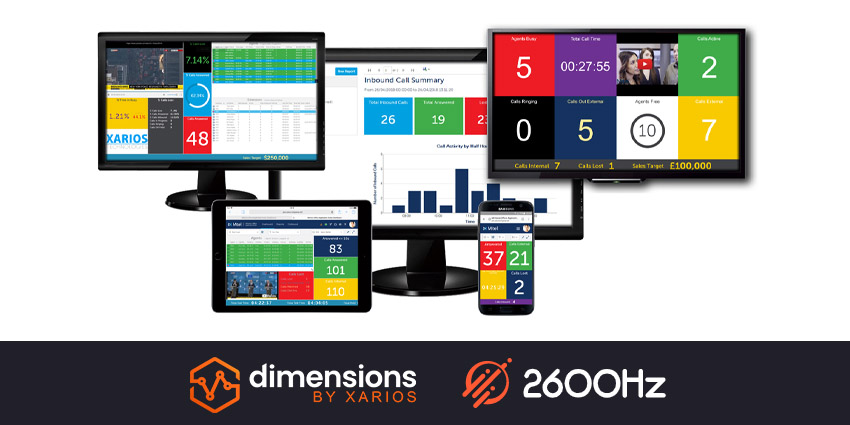Call Center Analytics During Remote Work

How Dimensions by Xarios’ Wallboard Call Center Analytics platform is helping managers to stay on top of their goals while working remotely.
Under ideal circumstances, taking your call center to a remote model is a task that you want to roll out over the course of a year or two. However, COVID-19 forced this multi-year process into a matter of two to three months.
In the rush to keep your operations running, it is easy to lose visibility into how your team is keeping up with the workload. Are the queues longer than they should be? Are calls taking too long? These and many other insights that can determine whether or not your team is on track can be hard to determine when everyone is dispersed
So how are call centers staying on top of their KPIs? In hopes of gaining a better understanding of how organizations are harnessing their call analytics tools, UC Today reached out to one of the leading providers of technologies for cloud call solutions 2600Hz to see what their customers are asking for to ensure that they don’t lose pace with their workload.
Defining the Need for Call Center Analytics
As a global company headquartered in San Francisco, 2600Hz works with resellers to offer their Kazoo platform. A highly scalable and customizable platform, Kazoo offers solutions for UC, Call Centers, SMS, and Remote Collaboration, and the ability to build out APIs for CPaaS, just to touch on a few of their markets.
Speaking with Alisa Bartash, 2600Hz’s Head of Marketing, she says that her customers are telling her that, “It’s not enough just to have that technological capability for call center staff to answer calls and take calls. Managers and administrators really need to know how long calls are lasting, if there are any, like VIP clients that are waiting an extraordinary amount of time and make sure that calls are being answered within a timely fashion.”
All of these indicators need to be tracked and analyzed, says Bartash, noting that, “This is important not only so that the call center can not only meet their own goals but ensure that they’re providing the best customer experience possible.”
In looking for a call center analytics solution that would offer their customers the insights they need, even when going remote, 2600Hz chose to include Wallboards from Dimensions by Xarios into their Kazoo platform.
Why 2600Hz Chose Dimensions by Xarios
Managers can use wallboards to provide a real-time snapshot of how their call center is performing. Drawing from Dimensions’ Call Analytics data, Wallboards pull together statistics such as the number of active or abandoned calls, wait times, as well as other bits that can help managers to quickly understand what their status is and where they need to direct their efforts to improve operations.
“It’s really just a helpful tool and an easy visual way for administrators and call center managers to keep track of their call center operations to make sure that everything is running smoothly so that they, in turn, can make sure that their customers are getting that optimal customer experience,” Bartash tells UC Today, explaining that, “They can easily jump in and start troubleshooting in real-time.”
A key feature that Bartash says her customers appreciate during the remote work situation is that they are able to stream the Wallboard onto any TV with an Amazon Firestick.
“They don’t need to source any hard to find devices,” she explains.
“Our partners can buy them and send them to their customers. Managers can just plug in the Firestick and have all of what they need to monitor on one screen at home”
As a developer of their own technology, it was interesting that 2600Hz chose to resell with Dimensions instead of building their own solution.
“We knew that we wanted to be able to offer high-level call center analytics,” says Bartash. “We realized that it would be better to partner with Dimensions than build their own because Dimensions’ solution was already so good. Their ability to make call center Wallboards easily accessible on a Fire TV stick is something that is unique to Dimensions, which is really great for us because then, in turn, we’re helping to offer our customers something that they can’t get anywhere else.”
What is Next for Call Center Analytics?
As call centers hope to ensure business continuity without dips in their level of service, Bartash sees an increased demand for analytics products in this space.
“The market is getting increasingly competitive right now as companies are working to stay ahead. It would be very easy for one of your customers to feel like they had a poor customer experience either because they had to wait on hold for too long, or because they couldn’t get to the right agent within a reasonable amount of time,” she says. “So, the most important thing is to make sure that you’re offering your customers the best service possible.”
Bartash points to the power of analytics to drive decisions on data and adjust accordingly. In the near future, she believes that visualizations of how the call center is performing will move beyond just the managers and become available for the calling agents as well.
“It needs to be even easier for both call center managers and call center agents to be able to view and access their analytics in an even more streamlined and easily accessible way,” she says, pointing to desktop apps so that agents will just need to download the one app to view their analytics. “They’ll be able to view their analytics and know if they are reaching their goals, no matter where they are.”
Thank you to UC today for their partnership on this article. Follow the link to read via UC Today
